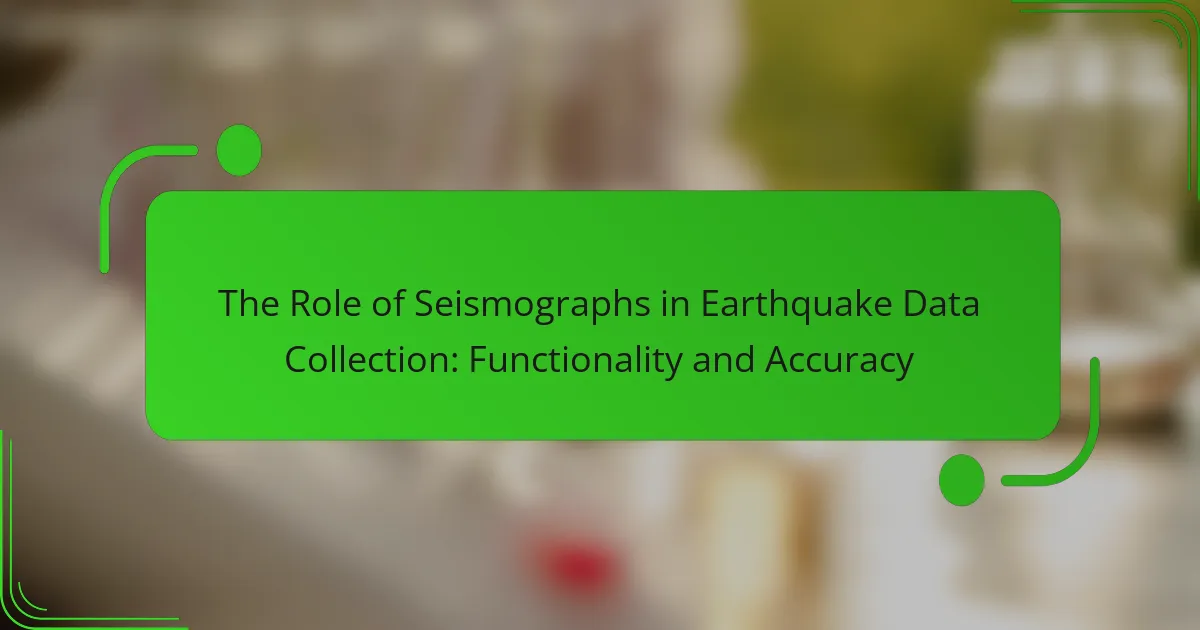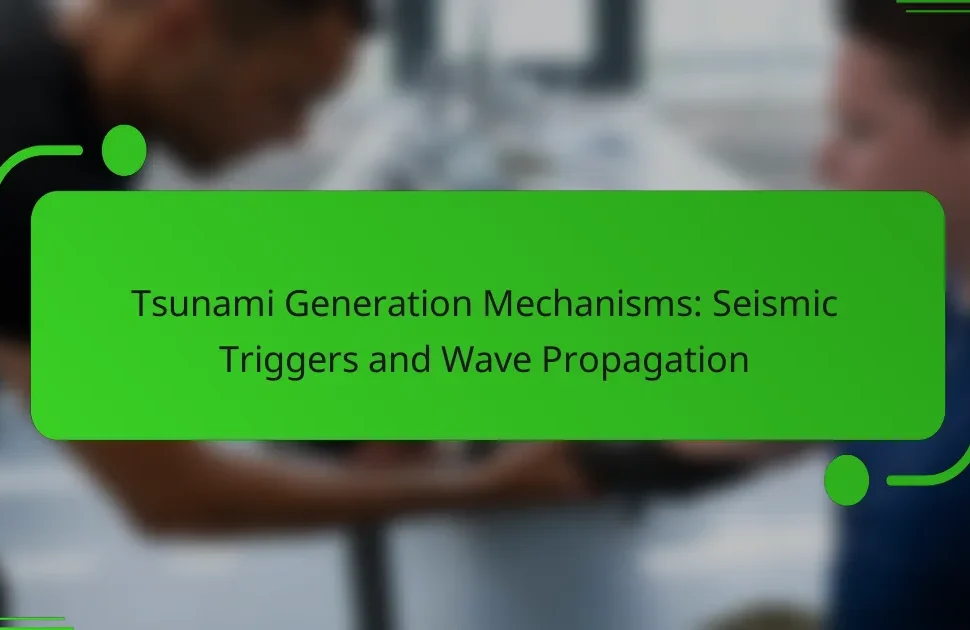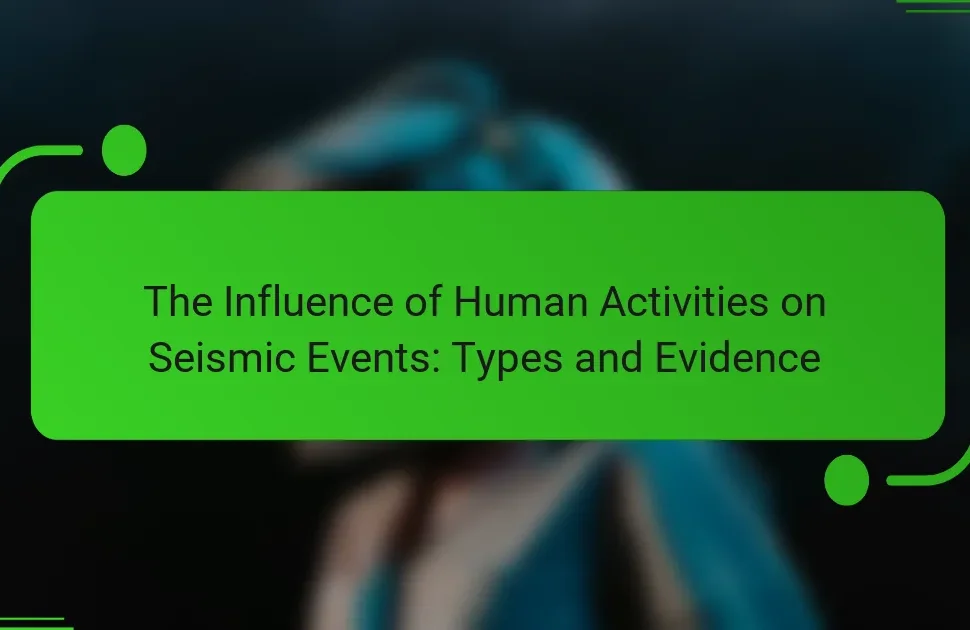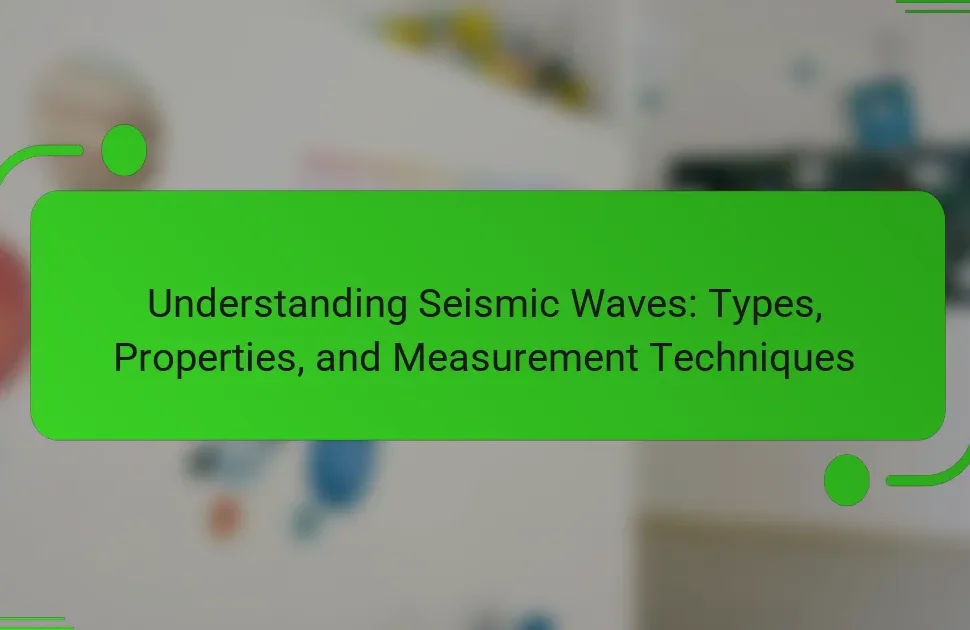Seismographs are specialized instruments designed to measure and record ground motion during seismic events, such as earthquakes. They operate by detecting vibrations and consist of a mass attached to a fixed base, allowing them to capture accurate data on the magnitude, depth, and location of seismic activities. This information is critical for earthquake research, safety enhancements, and the development of early warning systems. However, challenges such as noise sensitivity, calibration issues, and data transmission limitations can affect the accuracy of seismograph readings. The data gathered from seismographs has significant applications in earthquake monitoring, building design, tsunami warning systems, and geological research, ultimately contributing to public safety initiatives.
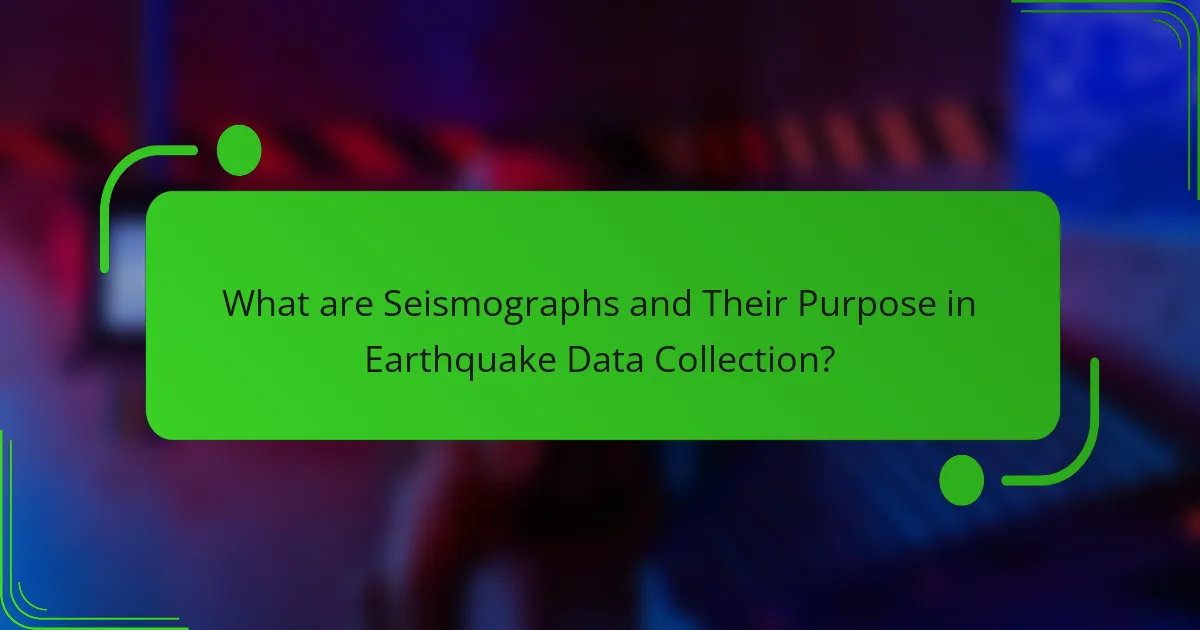
What are Seismographs and Their Purpose in Earthquake Data Collection?
Seismographs are instruments that measure and record the motion of the ground during seismic events. They detect vibrations caused by earthquakes and other ground movements. Seismographs consist of a mass attached to a fixed base. When the ground shakes, the mass remains stationary while the base moves, allowing the device to record the motion.
The data collected by seismographs is crucial for understanding earthquakes. It helps scientists analyze the magnitude, depth, and location of seismic events. This information is essential for earthquake research and improving safety measures. Seismographs also contribute to the development of early warning systems. These systems can alert communities before seismic waves arrive, potentially saving lives.
Seismographs have been used for over a century, evolving in technology and accuracy. Modern digital seismographs provide high-resolution data, enhancing our understanding of seismic activity. The information gathered from these instruments is vital for geologists and emergency response teams.
How do Seismographs Function in Monitoring Earthquakes?
Seismographs function by detecting and recording the vibrations caused by seismic waves during an earthquake. These instruments consist of a mass suspended on a spring, which remains stationary while the ground moves. When seismic waves reach the seismograph, the ground motion causes the mass to shift. This movement is translated into electrical signals. The signals are then recorded on a rotating drum or digitally stored for analysis. Seismographs can measure different types of seismic waves, including P-waves and S-waves. They provide crucial data for understanding the earthquake’s magnitude and location. The accuracy of seismographs has improved significantly with advancements in technology. Modern seismographs can detect even minor tremors, enhancing earthquake monitoring efforts.
What are the key components of a Seismograph?
A seismograph consists of several key components. The primary component is the mass, which remains stationary during ground movement. The second component is the spring, connecting the mass to the frame. This allows the mass to move freely in response to seismic waves. The third component is the recording device, which captures the movement of the mass. This device can be mechanical or digital, converting physical movement into a visual representation. The fourth component is the frame, which holds the entire structure in place. These components work together to accurately measure and record seismic activity.
How do these components work together to record seismic activity?
Seismographs consist of a mass, a spring, and a recording device. The mass remains stationary while the ground shakes during seismic activity. The movement of the ground causes the mass to move relative to the recording device. This relative motion is captured as a waveform on the recording medium. The spring allows the mass to return to its original position after the shaking stops. The recorded waveforms represent the amplitude and frequency of seismic waves. These characteristics help in analyzing the magnitude and depth of earthquakes. Seismographs are calibrated to ensure accurate data collection. This functionality is crucial for understanding seismic events and assessing risks.
What types of Seismographs are used in Earthquake Research?
There are several types of seismographs used in earthquake research. The main types include analog seismographs, digital seismographs, and broadband seismographs. Analog seismographs use mechanical components to record seismic waves on paper. Digital seismographs convert seismic waves into digital signals for computer analysis. Broadband seismographs can detect a wide range of frequencies, making them suitable for detailed seismic studies. These instruments are critical for understanding earthquake characteristics and improving predictive models. Their usage allows researchers to analyze data more effectively, enhancing earthquake preparedness and response strategies.
What are the differences between analog and digital Seismographs?
Analog seismographs record seismic waves on physical media, while digital seismographs convert these waves into digital signals. Analog devices use mechanical components to produce a continuous trace on paper. Digital seismographs utilize sensors and computers for data collection and processing.
Analog seismographs are limited in data storage and analysis capabilities. Digital seismographs can store vast amounts of data and allow for advanced analysis. Analog recordings can be susceptible to noise and distortion. Digital recordings maintain clarity and precision over time.
The transition from analog to digital technology has improved earthquake monitoring significantly. Digital seismographs provide real-time data and remote access to information. This shift enhances the accuracy and efficiency of earthquake data collection.
How do various Seismograph models impact data accuracy?
Different seismograph models significantly impact data accuracy. Each model has unique design features and operational principles. For example, broadband seismographs capture a wide range of frequencies. This allows them to detect both small and large earthquakes with high precision. In contrast, short-period seismographs are optimized for high-frequency signals. They excel in recording nearby seismic events but may miss distant quakes.
Additionally, digital seismographs offer enhanced data processing capabilities. They reduce noise and improve signal clarity compared to analog models. The calibration of each seismograph model also affects accuracy. Regular calibration ensures reliable readings and minimizes errors.
Research shows that the choice of seismograph can influence the interpretation of seismic data. A study published in the Journal of Seismology highlights how different models yield varying results in seismic event characterization. Therefore, understanding the strengths and weaknesses of each model is crucial for accurate data collection.
Why is the accuracy of Seismographs critical for Earthquake Data Collection?
The accuracy of seismographs is critical for earthquake data collection because it ensures reliable detection and measurement of seismic events. Accurate seismographs provide precise data on earthquake magnitude, location, and depth. This information is essential for assessing potential damage and formulating effective response strategies. Inaccurate readings can lead to misinterpretation of seismic activity, resulting in inadequate preparedness. For example, the 2011 Tōhoku earthquake in Japan highlighted the importance of accurate seismic data for timely evacuation and disaster response. Reliable seismograph data also aids in advancing scientific research on earthquake behavior and risk assessment.
What factors influence the accuracy of Seismographs?
The accuracy of seismographs is influenced by several key factors. These include the sensitivity of the instruments, which determines their ability to detect small seismic waves. Calibration is crucial; improperly calibrated seismographs can yield inaccurate readings. Environmental conditions, such as temperature and humidity, can affect the performance of the equipment. The geological characteristics of the installation site also play a role; different materials can absorb or reflect seismic waves differently. Additionally, the type of seismic waves being recorded, such as P-waves or S-waves, impacts the accuracy. Finally, human error in data interpretation can lead to inaccuracies in the analysis of the recorded data.
How do calibration and maintenance affect Seismograph performance?
Calibration and maintenance are crucial for optimal seismograph performance. Calibration ensures that the seismograph accurately measures ground motion by adjusting its sensitivity and response characteristics. Regular maintenance prevents mechanical failures and ensures the integrity of the equipment. Studies show that poorly maintained seismographs can produce erroneous data, leading to inaccurate earthquake analysis. For instance, the National Earthquake Information Center emphasizes that consistent calibration can improve data reliability by up to 30%. Properly functioning seismographs contribute to better earthquake prediction and response strategies.
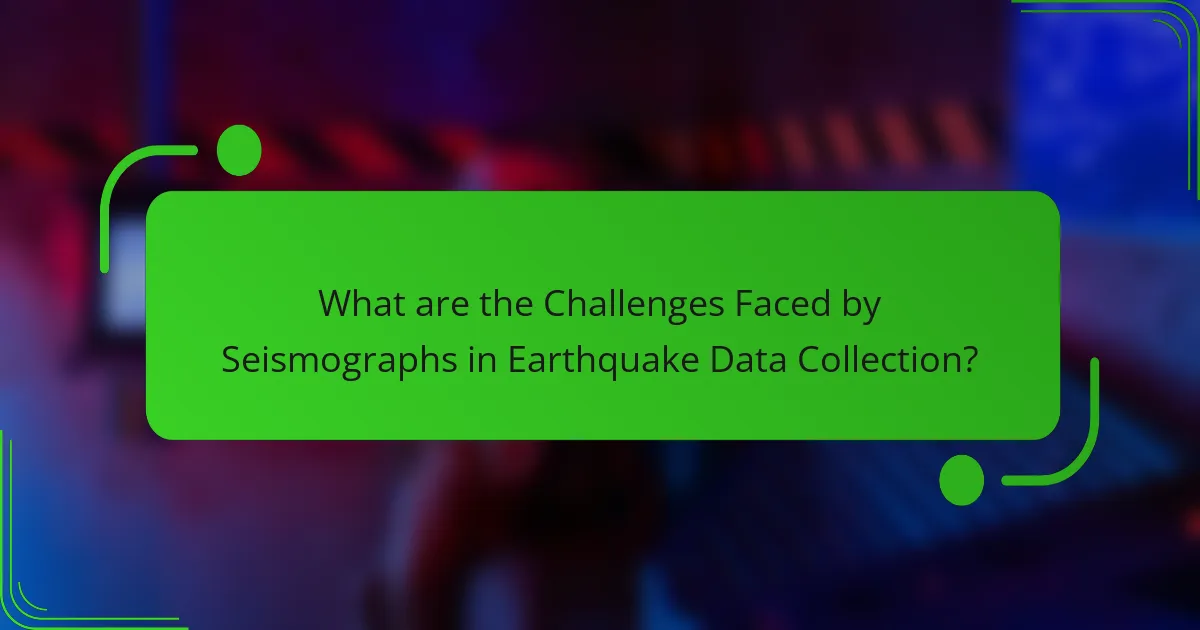
What are the Challenges Faced by Seismographs in Earthquake Data Collection?
Seismographs face several challenges in earthquake data collection. One major challenge is the sensitivity to noise. Environmental vibrations can interfere with accurate readings. Another challenge is the calibration of instruments. Improper calibration can lead to erroneous data. Seismographs also struggle with data transmission. Remote locations may hinder real-time data sharing. Additionally, the design of seismographs can limit their effectiveness. Some models may not capture high-frequency waves. Lastly, the interpretation of data poses challenges. Analysts must differentiate between seismic events and background noise. These factors collectively impact the reliability of earthquake data collection.
What environmental factors can interfere with Seismograph readings?
Environmental factors that can interfere with seismograph readings include ground vibrations from human activity, such as construction and traffic. Weather conditions, like heavy rain or snow, can also affect readings by altering ground stability. Additionally, geological features, such as nearby faults or rock formations, may distort seismic waves. Electromagnetic interference from power lines and electronic devices can disrupt sensor accuracy. Temperature fluctuations can cause expansion or contraction in the equipment, impacting its performance. Lastly, animal movements near the seismograph can generate false signals. Each of these factors can lead to inaccurate data collection and analysis.
How do geological conditions impact Seismograph effectiveness?
Geological conditions significantly impact seismograph effectiveness. Different soil types, such as clay or sand, affect seismic wave propagation. Hard rock generally transmits seismic waves more efficiently than softer materials. This difference can lead to variations in recorded amplitude and frequency. For instance, seismic waves may be amplified in softer soils, leading to distorted readings. Additionally, geological features like faults and fractures can alter wave paths, complicating data interpretation. Studies show that seismographs placed on solid bedrock provide more reliable data than those on unstable ground. Thus, understanding local geology is crucial for accurate seismic monitoring.
What role do human activities play in data distortion?
Human activities significantly contribute to data distortion in seismographic measurements. Construction, mining, and other industrial activities create vibrations that can interfere with seismic readings. These activities generate noise that masks genuine seismic signals. For instance, heavy machinery can produce ground vibrations similar to those caused by earthquakes. Research indicates that urbanization increases background noise levels, complicating data interpretation. Additionally, human-induced seismicity, such as fracking, can create artificial seismic events. This further complicates the analysis of natural seismic activity. Accurate data collection requires distinguishing between natural and human-induced signals. Therefore, understanding human activities is crucial for improving seismic data accuracy.
How can technology improve Seismograph accuracy and functionality?
Technology can improve seismograph accuracy and functionality through enhanced sensors and data processing. Advanced digital sensors provide higher sensitivity and precision in detecting seismic waves. These sensors can capture a wider frequency range, allowing for better differentiation between types of seismic events. Machine learning algorithms can analyze seismic data in real-time, identifying patterns and anomalies more efficiently. Cloud computing enables the storage and processing of large datasets, improving accessibility and collaboration among researchers. Enhanced communication technologies allow for quicker data transmission from remote locations. Integration with GPS technology improves the ability to monitor ground movement with higher accuracy. Overall, these advancements lead to more reliable earthquake predictions and assessments.
What advancements are being made in Seismograph technology?
Advancements in seismograph technology include enhanced sensitivity and real-time data processing. Modern seismographs utilize digital sensors that provide more accurate readings. These sensors can detect smaller seismic events than traditional analog systems. Additionally, advancements in software allow for improved data analysis and visualization. Machine learning algorithms are being integrated to predict earthquake patterns. Wireless technology enables remote monitoring and quicker data transmission. These innovations contribute to better earthquake preparedness and response. Recent studies show that digital seismographs can reduce detection thresholds significantly.
How do software updates enhance data collection and analysis?
Software updates enhance data collection and analysis by improving the functionality and accuracy of seismographs. These updates often include new algorithms that refine data processing capabilities. Enhanced algorithms can filter out noise, leading to clearer signals. This results in more accurate earthquake detection and measurement. Additionally, software updates may introduce new data visualization tools. These tools help researchers interpret data more effectively. Improved user interfaces can streamline data entry and management. This increases efficiency in data collection processes. Overall, software updates ensure that seismographs operate at their highest potential, leading to better data quality.
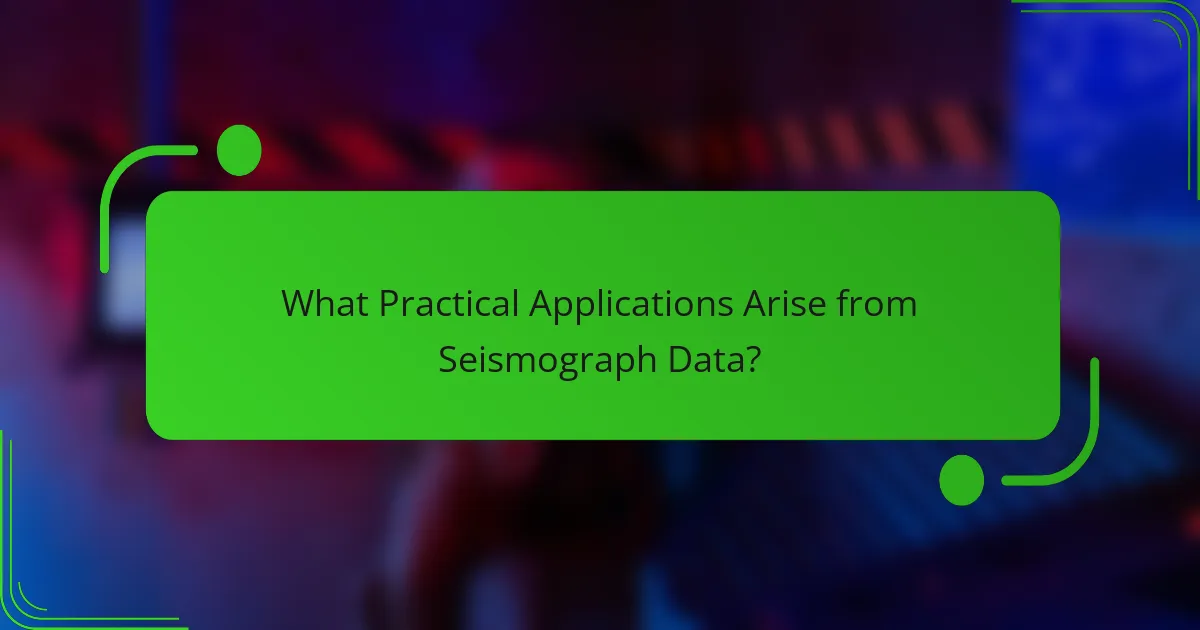
What Practical Applications Arise from Seismograph Data?
Seismograph data has several practical applications. One primary application is earthquake monitoring. Seismographs detect and record ground motion, providing real-time data on seismic events. This data helps scientists analyze the magnitude and depth of earthquakes. Additionally, seismograph data is used in building codes. Engineers rely on this information to design earthquake-resistant structures. Seismographs also aid in tsunami warning systems. They help identify undersea earthquakes that may trigger tsunamis. Furthermore, seismograph data contributes to geological research. It enhances understanding of tectonic plate movements and fault lines. Lastly, seismographs support public safety initiatives. They provide critical information for emergency response planning.
How is Seismograph data used in earthquake preparedness and response?
Seismograph data is used to monitor and analyze seismic activity for earthquake preparedness and response. This data helps in identifying the location, depth, and magnitude of earthquakes. Real-time seismograph readings allow emergency services to respond quickly to seismic events. Historical data from seismographs aids in assessing risk levels in different regions. By analyzing patterns in seismic activity, scientists can improve early warning systems. These systems can alert communities seconds to minutes before shaking occurs. Such alerts can significantly reduce injuries and fatalities during an earthquake. According to the U.S. Geological Survey, timely warnings can lead to better evacuation and emergency management strategies.
What role does Seismograph data play in urban planning and safety?
Seismograph data is crucial for urban planning and safety. It provides real-time information about seismic activity. This data helps identify earthquake-prone areas. Urban planners use this information to design buildings that can withstand earthquakes. For instance, the U.S. Geological Survey states that seismographic data informs building codes. Accurate data can reduce damage and save lives during seismic events. Additionally, cities can develop emergency response plans based on seismograph readings. This proactive approach enhances community resilience against earthquakes.
How do researchers utilize Seismograph data for scientific studies?
Researchers utilize seismograph data to analyze and understand seismic activity. Seismographs record ground motion caused by earthquakes and other seismic events. This data helps researchers identify the magnitude and depth of earthquakes. It also aids in determining the location of tectonic plate boundaries. Additionally, researchers use seismograph data to study the Earth’s internal structure. This includes analyzing wave propagation through different geological materials. Seismograph data contributes to earthquake prediction models and hazard assessments. Furthermore, it supports the development of building codes for earthquake-resistant structures. Overall, seismograph data is essential for advancing seismology and improving public safety.
What best practices should be followed for effective Seismograph data collection?
Effective seismograph data collection requires precise calibration and maintenance. Regularly calibrating seismographs ensures accurate measurements. Proper site selection is crucial; avoid locations with excessive noise or vibrations. Use high-quality sensors to enhance data reliability. Implement real-time monitoring to detect and address issues promptly. Data storage should be secure and organized for easy access. Regularly review and analyze collected data for consistency. Training personnel on equipment operation improves data quality. Following these practices leads to more reliable earthquake data.
How can users ensure optimal performance of Seismographs in the field?
Users can ensure optimal performance of seismographs in the field by following specific operational guidelines. Regular calibration is essential to maintain accuracy. Proper installation on stable ground minimizes noise interference. Users should also protect the equipment from environmental factors like moisture and extreme temperatures. Routine maintenance checks help identify potential issues early. Additionally, ensuring the correct settings for data collection enhances performance. Training personnel on proper usage and troubleshooting is crucial. Finally, using high-quality components can improve overall reliability. These practices are supported by industry standards for seismic monitoring.
What common troubleshooting tips can enhance Seismograph reliability?
Regular calibration enhances seismograph reliability. Calibration ensures accurate readings by adjusting for any discrepancies. Check the power supply frequently to avoid interruptions. A stable power source prevents data loss during operations. Inspect the sensor and installation for any physical damage. Damaged components can lead to false readings. Ensure proper grounding to reduce electrical noise interference. Grounding stabilizes the signal and improves data accuracy. Maintain environmental conditions around the seismograph. Extreme temperatures or humidity can affect performance. Regularly update software and firmware to fix bugs. Software updates enhance functionality and reliability. Conduct routine maintenance checks to identify potential issues early. Preventative maintenance can prolong the lifespan of the equipment.
Seismographs are specialized instruments used to measure and record ground motion during seismic events, playing a crucial role in earthquake data collection. The article explores the functionality and accuracy of seismographs, detailing their components, types, and the impact of technology on their performance. It highlights the importance of accurate data for earthquake monitoring, risk assessment, and urban planning, while addressing challenges such as noise interference and calibration issues. Additionally, the article discusses best practices for effective data collection and the practical applications of seismograph data in enhancing public safety and scientific research.
